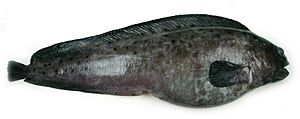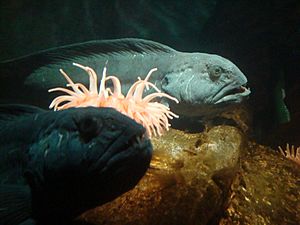Northern wolffish facts for kids
Quick facts for kids Northern wolffish |
|
|---|---|
 |
|
| Conservation status | |
|
Invalid status (NatureServe)
|
|
| Scientific classification | |
| Synonyms | |
|
The northern wolffish (Anarhichas denticulatus) is a unique type of fish. People also call it the blue sea cat or jelly cat. It is a marine ray-finned fish and belongs to the wolf fish family, Anarhichadidae. You can find this fish living in the cold waters of the North Atlantic Ocean and the Arctic Ocean.
Contents
About the Northern Wolffish Name
The northern wolffish was first officially described in 1845. A Danish zoologist named Henrik Nikolai Krøyer gave it its scientific name. He found it near Greenland.
The name denticulatus means "having fine teeth." This name describes the northern wolffish's teeth. They are sharper and more pointed compared to its cousin, the Atlantic wolffish.
What the Northern Wolffish Looks Like

The northern wolffish is a strong, long fish. It has a big head, a sharp snout, and small eyes. Its teeth are very special and stand out. It has large, canine-like teeth at the front of its jaws. At the back, it has teeth that look like molars. This fish does not have any pelvic fins.
Its body color is usually grayish to dark brown. It often has a light purplish shine. You might also see many faint dark bars or spots on its skin. The fish's muscles are soft and feel like jelly. The teeth on its vomer bone are large. They can be rounded or pointed. These teeth reach back to the line of teeth on its palatine bone. Its tail fin is flat and has between 18 and 22 fin rays. This fish can grow up to 180 cm (71 in) (about 6 feet) long. It can weigh as much as 20 kg (44 lb) (about 44 pounds).
Where the Northern Wolffish Lives
The northern wolffish lives in the North Atlantic and Arctic Ocean. You can find it in many cold places. These include the Barents Sea and Norwegian Sea near Spitsbergen. It also lives near Iceland, the Faroe Islands, and southern Greenland.
It swims south along the east coast of North America. It can be found almost as far as Cape Cod. To the west, it reaches Prince Patrick Island in Canada's Northwest Territories. Some have even been seen in the northern North Sea and the Bay of Biscay.
This fish prefers open ocean areas. It lives in the deep waters of the continental shelf. It has been found as deep as 1,325 m (4,347 ft) (over 4,300 feet). This is the deepest any wolffish has ever been seen. It mostly lives freely in the water, not on the bottom. Sometimes, it even swims up closer to the surface.
Northern Wolffish Life Cycle and Diet
Northern wolffish use large rocks for shelter. They also build nests there. Late in the year, female wolffish lay many large eggs. They can lay about 46,500 eggs. Each egg is about 8 mm or 5⁄16 inch wide. These eggs sink to the sea floor. The male fish then guards the eggs in the nest until they hatch.
These fish grow slowly. They become adults when they are five years old or older. They can live for at least 12 years. Unlike other wolffish, northern wolffish can be found swimming off the bottom. This is true for both young and adult fish. They do not swim in large groups or travel long distances.
This fish eats in the open water. Its diet includes comb jellies and jellyfish. It also eats creatures that live on the sea bottom. These include crustaceans like crabs. It also eats invertebrates such as sea urchins, brittle stars, and starfish.
Protecting the Northern Wolffish
The northern wolffish is a protected species in Canada. It is listed as a Threatened species under the Canadian federal Species at Risk Act (SARA). A special team is working to help this fish recover. They are also helping the spotted wolffish.
This team is creating a plan to improve the status of these fish. They want to learn more about their lives. They also want to understand what might harm them. The plan includes rules for fishing. For example, if a wolffish is caught by accident, it should be released alive. The plan also involves protecting their homes. Education programs help people learn about these fish. This helps everyone get involved in protecting them.
In Europe, the northern wolffish is considered Endangered. This is because they do not move around much. Many are also caught by accident when people are fishing for other species. Climate change caused by humans is also a big threat. Experts believe that the number of northern wolffish in the northeastern Atlantic has dropped by more than half in the last three generations.


